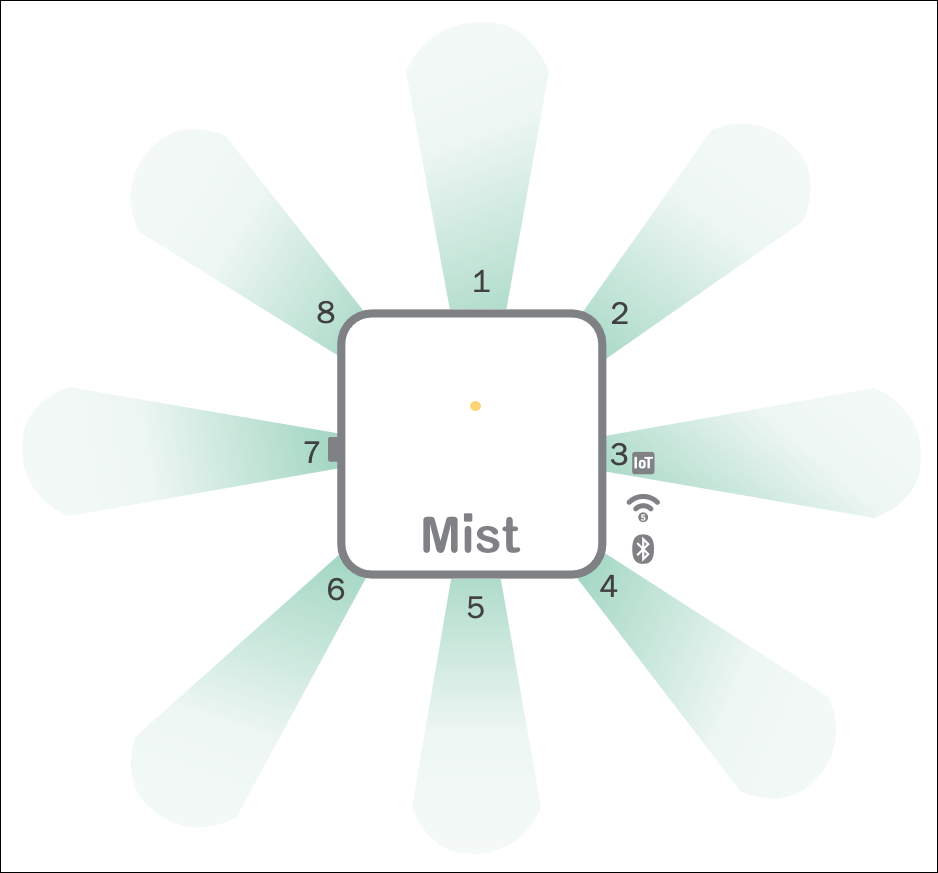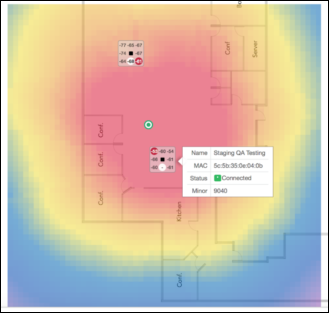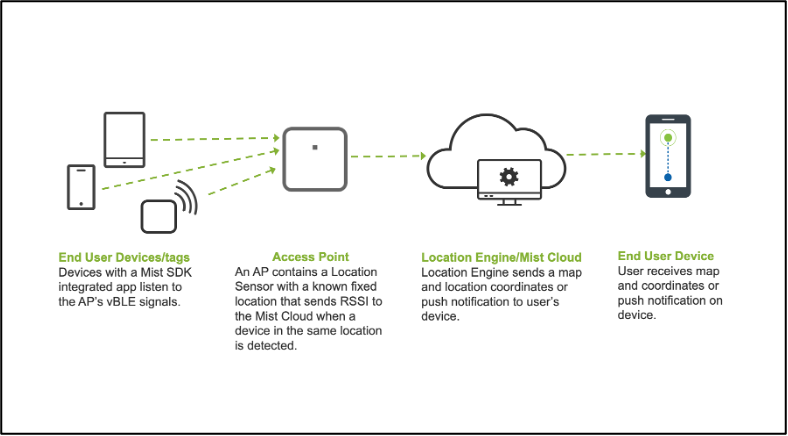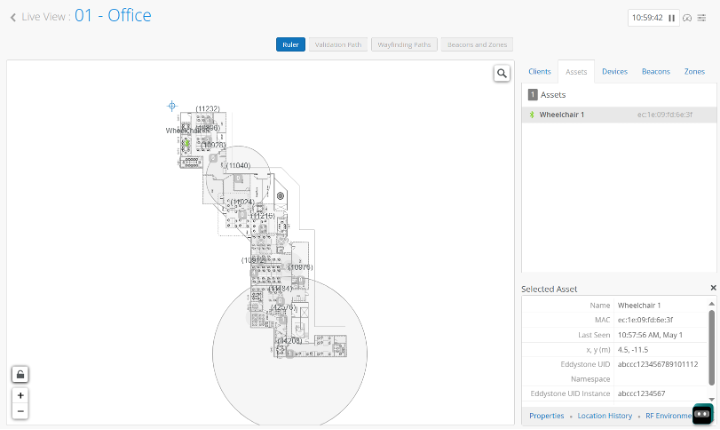Juniper Mist定位服务概述
熟悉基于位置的服务的主要组件,了解 Juniper Mist™ 如何确保定位准确性,从而实现寻路、资产可见性和用户参与。
虚拟蓝牙 LE (vBLE) 是一项用于室内定位服务的专利技术,使用虚拟信标非常精确地定位 BLE 设备。瞻博网络接入点 (AP) 采用动态 8 向天线阵列,用 BLE 信号覆盖某个区域,同时能够发射和接收 BLE 信号。
与物理信标相比,虚拟信标在节省时间和成本方面是一种有效的替代方案。使用虚拟信标,无需安装和配置物理信标,无需现场勘察,也无需额外的硬件。这使得部署更简单、更高效,并使添加和移动 vBeacon 成为一种轻松的体验,因为您可以从Juniper Mist™门户配置所有内容。
Indoor location services provide a huge opportunity to engage with employees, guests, and customers while optimizing resources to save time and money. But widespread adoption of these services has been limited by physical beacons and costly site surveys. They just don't scale.
This all changes with MIST. With the invention of scalable enterprise-grade BLE, we flipped the model by virtualizing the indoor location experience. Here's how.
Our patented BLE directional antenna array enables all MIST endpoints to blanket an entire location with BLE. Location is computed in the MIST Intelligent Cloud. This lets you go beyond just listening to a tag to interacting with an entire space.
With this new model, beacons are completely virtual. Create as many as you want, wherever you want, and change them as often as you want. Without the hassle and cost of physical beacons.
With machine learning, manual calibration and site surveys are a thing of the past. The MIST platform also includes comprehensive zone analytics, like visits and dwell times, providing rich insight into personnel and resource utilization. The world is ready for new indoor location experiences.
Now you are too. MIST. Smart wireless for the smart device era.
工作原理:vBLE 天线阵列
Juniper Mist AP 使用 8 元素定向 vBLE 天线阵列传输 BLE 信号。

So the MIST Mobile SDK is responsible for receiving the BLE RSSI information and combining it with sensor data from the mobile device and sending that back to the cloud every second while the mobile device is moving. The MIST machine learning system continuously adapts to changing RF environments without the need for site surveys. Unlike single antenna BLE designs, MIST uses a single transmitter to drive eight unique directional antennas.
Each beam contributes to the likely location of the device. The MIST technology examines all the probability surfaces, one for each directional beam, and combines them to find the most likely point in the map where the device is located. So two terms of importance are PLE and intercept.
PLE is the path loss exponent. MIST uses this formula to determine the expected signal strength at various locations on a map based on a gain at that direction from the antenna, taking into account orientation and ceiling height. The intercept is another constant that must be derived.
It is much like the intercept of a line and indicates the expected power at one meter from the antenna. Individual RF environments and even device types have different optimal PLE and intercept values. This ensures the RF model adapts to the RF environment as it changes and accounts for the differences between mobile device types, providing a consistent user experience.
The essential element behind MIST machine learning is to seek the maximum agreement between the results of increasingly many location estimates. From that, construct individualized path loss formulas. As the machine learning algorithm begins, it's using the default PLF for a device type, meaning an iPad, an iPhone 6, an iPhone 6S.
Machine learning is running continuously. The only time you would see an AP at zero learning is when it was just added to the map or something has been changed in its configuration regarding ceiling height, orientation, etc. The thing to look for here is to make sure all of your APs are learning.
To reach level one usually only takes a couple minutes for a device, and that's the most important level because 95% of the work is done reaching level one learning. After that, the algorithm is looking for new unique data points. We have created this visual to help you quickly understand the status of location machine learning.
If an AP is not learned on a device, it will be gray. When all the devices are learned, they will show green. So what is going on here? Using the show all button, you can see the raw data, and note you can also choose to expose just a single device.
What the UI has done is to add up the PLE and intercept. Then a median value is derived per device, and per AP, a variance from that median is shown. In a normal environment, we would expect this variance not to be more than one or two.
If it is three or four, the tile will show yellow, and more than five will be red. This is to alert you to take a look at why this AP may be so different from the others. So in this case, this is what I would expect.
If you saw a five or a six, something that is kind of radically different from the others, immediately I would go look at the floor plan and see if that AP is in a strange spot that would justify it having a much different PLF than the rest of the APs.
工作原理:概率面
当您的客户或访客使用支持 Juniper Mist SDK 的应用时,Juniper Mist云会使用概率面来确定用户的位置。概率面以亚秒级延迟提供最佳定位精度。
Juniper Mist云通过 SDK 客户端发送的射频指纹创建概率面。方法是将平面图拆分为 1 米的正方形,然后计算每个正方形的估计射频指纹。
AP 的 8 个定向波束中的每一个都对客户端设备的可能位置产生影响,检查所有概率面(每个波束一个)并将它们组合在一起以在地图上找到设备所在的可能点。
在此示例中,红色区域的中心是表面的峰值,也是客户端位置的最高概率。蓝色区域表示表面的最低区域和客户端位置的最小概率。

当 SDK 客户端将射频指纹发送到Juniper Mist云时,Juniper Mist进入机器学习过程,并针对该设备优化定位模型。
工作原理:室内定位体验
Juniper Mist SDK 提供了构建面向客户的应用以提供室内定位服务所需的工具。将 Juniper Mist SDK 与Juniper Mist Wi-Fi 和基于位置的服务集成后,您可以使用 Juniper Mist 的专利 vBLE 技术确定用户的位置并发送基于距离的通知。
集成 SDK 的移动设备侦听并接收由 AP 传输的蓝牙低能耗 (BLE) 数据包。这些数据包中的信息由 SDK 客户端打包并发送到Juniper Mist云。最后,云根据接收到的信息每秒将 x,y 坐标返回给移动设备。
有关更多信息,请参阅 Juniper Mist SDK。
应用程序使用此信息来提供相关体验,例如寻路方向和推送通知。
 显示用户位置
显示用户位置
用例
Juniper Mist支持许多基于位置的用例。下面介绍几种可能性。
寻路
寻路就像 Google 和 Apple 地图的体验一样,将您从 A 点导航到 B 点。
想象一个零售店。顾客在商店购物,他们的手机上安装了零售商的移动应用程序。传输 BLE 的接入点遍布整个商店。如果您将 SDK 集成到面向客户的应用程序中,则可以支持寻路。零售客户可以搜索商品,然后被引导到商店内商品的位置。
有关更多信息,请参阅 寻路用例。
This is a great example of an indoor wayfinding experience. Here they just want to find the business center. A customer used the Myst SDK to create a mobile app for their visitors.
Start walking, but since these are long hallways they probably won't be staring at the phone the entire time. And there you go.
资产可见性
快速找到电子产品和设备等资产。要支持资产跟踪,请将 BLE 信标标记附加到要跟踪的资产。当 AP 听到来自标记的 BLE 传输时,它会在Juniper Mist门户的实时取景中找到该资产。医院的工作人员可以使用此功能来追踪轮椅等医疗设备的位置。
有关详细信息,请参阅 查找设备用例。
So let's go into some of the enterprise use cases. What do we see in the enterprise? Again, the theme is very similar. It's all about wayfinding. It's all about for better associated experiences. It's all about asset visibility around guest management with the management. It's all about occupancy, and it's still very relevant about proximity tracing.
We still have a lot of customers as they're opening up the enterprise office again with the pandemic numbers looking better in the right direction. They are looking to enable solutions in their network that can enable all of these four use cases, and in addition to that, get benefits from our simplified network operations, leveraging Marvis and AI-Ops. In the enterprise space, we have a lot of partners.
I'll call out one here specifically Inpixon, which has Jibestream mapping system, as well as the CX app enterprise platform that enables room booking that interacts with the Active Directory system for employees and enables the wayfinding and push notification experience that we're seeing a lot of traction with. So in healthcare, Bob, would you like to talk about some of the healthcare use cases that we see? Yeah, I mean, as I mentioned, healthcare is like where indoor location actually started a few years ago, and so probably my favorite indoor location right now is really around what I call Uber Health. This is really where hospitals are looking at trying to help vets or patients who actually need wheelchairs, right? So this is almost like a checkout procedure, right, where you need to check out, and they need to take you to the front door in a wheelchair, and you're sitting there waiting for the wheelchair to arrive.
So I've been working with a couple hospitals on how do you make that patient experience nicer so at least when they're waiting there, they have a sense that, yes, the wheelchair is on arrival, and this is why I call it the Uber thing, right? You know that the wheelchair is on its way, and how long it's going to take you there. The other use case I've seen in healthcare, and this may apply to other businesses, is really just around asset tracking, you know, where they have to basically identify or locate all their assets every year on an annual basis, or they have high-value assets. I've worked with a couple of hospitals.
It's amazing, even vacuum cleaners, how much stuff gets... It doesn't get stolen, but it gets lost quite, you know, it tends to get misplaced and lost by a regular. So those are some of the more typical use cases I've seen in the healthcare space, along with kind of the wayfinding through the mazes. You know, some of these hospitals I've been in, like, you can't actually get lost in them.
You know, I bet there's a famous story of someone who was, like, looking for her mother in a hospital. It was, like, midnight, you know, and she's wandering the hospital trying to find help on finding out, you know, where her mother's room was. So that's typical healthcare space use cases.
And Bob, you want to talk a little bit about that door control system, the enabled leveraging location and our IoT hub on the access points for one of our... Oh, yeah, yeah, yeah. This is for, you know, Alzheimer patients. You know, you're in a hospital where they really want to make sure that if anyone approached a door, the door would automatically lock, right? And so this is making sure if you're in a hospital or healthcare space where you're dealing with patients who have, you know, memory issues, you don't want them wandering off.
So this is kind of where we actually use the IoT port on AP to actually lock the door in conjunction with the virtual BLE when someone got too close to the door type of patient. And that was a very interesting use case where we're using location along with our IoT port to enable an outcome of locking the door based on who was in proximity of that door. In higher Ed, again, the theme is the same, mobile app engagement asset visibility, but here it's all about wayfinding for students, for students with visiting families.
Push notifications are really key when you're doing events in the stadiums, when you're doing, you know, visiting guest speaker lectures. In fact, we work with a very famous university here in the Bay Area where they wanted to enable wayfinding for visiting faculty. And as the visiting faculty or the students went from one auditorium to another, while they were passing that room, they wanted to enable push notifications to let them know what is the session that's going on in that room right now so that you could drive more attendance into those areas.
And then again, from an asset visibility perspective, whether it's tracking chairs in a conference room, whether it's tracking, now we see a lot more IT assets also, for example, with Chromebooks and iPads being given to students, being able to track that. And then even in the higher Ed university use case, we're seeing Bluetooth being used for asset visibility from an IT management perspective. Yeah, I mean, here's a good question.
I think we probably should wrap up. We only have a few minutes left here. It's really around random MACs and, you know, what does random MACs mean for Wi-Fi locations? And that's a great question.
So, random MACs were always a problem statement in the unconnected Wi-Fi world where we were seeing a lot of random Macs and we would discard the random Macs due to sort of the occupancy and density of spaces being utilized and traffic flows. Now we're also seeing random MACs show up in the connected Wi-Fi world. And that is again, where for customers who now are looking at people counting solutions, especially in retail or in the enterprise space, we sort of talk a little bit more about leveraging the mobile app or the badge as a way to get that data, which is relying on Wi-Fi to count devices because of the random MAC phenomena.
And the random MAC again is driven by privacy. So, I would say the short answer on the random MAC is it's kind of eliminated the ability to do history. I mean, we used to be able to track, you know, how many times you showed up in a coffee shop or something. All that's pretty much been eliminated now with the random MAC. And the last use case around retail, and we just spoke about that. So again, here we know big box retail, we know malls, they want to deploy, you know, turn-by-turn navigation.
Some of our customers also want to make sure that if you're at the pharmacy section, you get a push notification show up on when your prescription will be ready, or if you're in the store and not visiting pharmacy, remind you that, hey, your prescription will be ready if you're here to pick it up. So a lot of use cases around push notification and retail, around wayfinding and big box retail, pristine malls, and all enabled by the Mist SDK and the Mist platform. Hand in hand with that is the Engagement and Occupancy analytics, because the number one thing that we always get back is, hey, just based on the Wi-Fi data today, can I do some sort of analysis on trends of which areas are visited with being visited more, what's less, what part of day, what day of week, what is my average? Well, again, not a people-to-contact solution, but still gives you a very good idea of how our spaces are utilized in terms of density and dwell time in the retail space.
用户参与
当站点访问者进入虚拟信标的覆盖区域时,定位引擎会发送推送通知以显示问候语。这方面的一个例子是,当一个人从办公楼的前门进入时,指向公司主页的重定向链接被发送到他们的设备。

Now, to show you in real-time how we deliver people tracking with our user engagement solution stack, we'll give you a demo of a corporate space with real-time wayfinding, as well as a warehouse space where we are tracking people for analytics, but also delivering real-time wayfinding with the use case being imagine a runner coming to pick an order in a store and not knowing where things are because they're not the store employee. This is the Juniper EBC. We're using our device to navigate to the Thomas Edison room.
We use a device map to begin our walk. What is far more interesting is what's going on behind the scenes. A missed access point is a platform that not only provides Wi-Fi but also high accuracy location services.
In the wayfinding use case, we use the 16 antenna directional Bluetooth array as unique transmitters. What we see here is RF glasses, a troubleshooting microservice spun up that let us see inside the device. Note the different estimates calculated to provide a high-quality blue dot.
Also note, MIST is measuring the amount of beams it hears over time, as well as speed and direction directly from the device sensors to fuse this data into a great wayfinding experience. How cool and easy are push notifications? These can be created, enabled, disabled by an API based on time, time of day, or anything you want. How cool is that? Here is a high ceiling warehouse example using the MIST experience app.
We have enabled some debugging features like breadcrumbs and arrows showing which way the device is actually pointed in space. Looking behind the scenes, we use RF glasses to see what the device actually sees. Here are the beams it hears the loudest during this interval from multiple MIST access point platforms.
We can see the beams heard over time as well as getting information on speed and direction directly from the device sensors as well as network round-trip time. This demonstrates the versatility of the access point as a platform and the multiple types of high accuracy location-based services.

